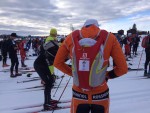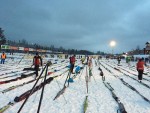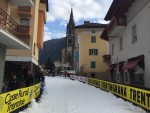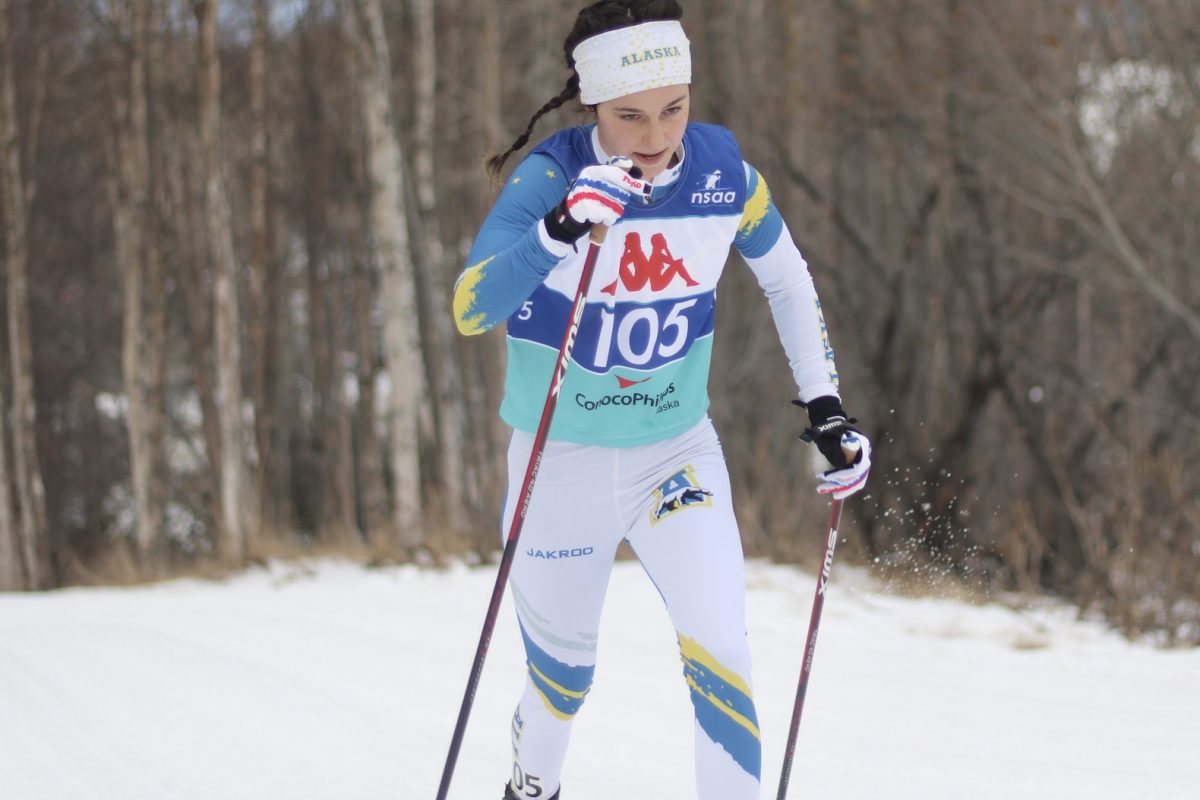
(Editor’s note: JoJo Baldus is a nordic skier from snowy Minneapolis, Minn., who spent this past winter “living the dream,” as he described it, as a volunteer journalist and photographer for FasterSkier while enjoying a gap year before starting at Macalester College in St. Paul. He set a goal to complete nine Worldloppet ski races this winter, three of which were canceled due to low snow. He did five — including the Finlandia-Hiihto — but did not race the Jizerská because it was shortened. This is a tale of his most memorable experiences.)
***
People travel in a wide variety of ways and for quite varying reasons. Many flock like pigeons to big, famous, ridiculously densely populated cities. Historic sites often attract the hordes. And the great outdoors also allure many travelers.
Being on a ‘gap year’ exploring Europe before college, I immersed myself in the international ski scene this winter. It is just my kind of travel: being outdoors, meeting interesting skiers from all over the world, and experiencing different ski cultures from one country to the next. Italy and Finland and Norway, oh my!
After following around the World Cup race scene in December and January reporting for FasterSkier, interviewing athletes and photographing races at the Tour de Ski, I embarked on what I called a marathon of ski marathons. Originally I prepared myself to endure these nine Worldloppet races:
- Jan. 10: Jizerská 50: 50 k classic, Liberec, Czech Republic
- Jan. 24: Dolomitenlauf: 60 k skate, Lienz, Austria
- Jan. 31: Marcialonga: 70 k classic, Predazzo, Italy
- Feb. 6: König Ludwig Lauf: 50 k skate, Oberammergau, Germany*
- Feb. 14: La Transjurassienne: 68 k skate, Morez, France*
- Feb. 21: Tartu Marathon: 63 k classic, Tartu, Estonia*
- Feb. 28: Finlandia-Hiihto: 50k skate, Lahti, Finland
- March 6: Vasaloppet: 90 k classic, Mora, Sweden
- March 19: Birkebeinerrennet: 54 k classic, Rena, Norway
Of course the weak winter that plagued Central Europe this year had a different vision. The Konig Ludwig Lauf, La Transjurassienne, and Tartu Ski Marathon were all unfortunately canceled (*see above) due to a lack of snow and soberingly warm temps. But the golden lining — you appreciate each of the other races just that much more!
As winter melts away to spring and we mournfully watch the beautiful white snow turn to brown slop, we can keep the season alive a little longer by recalling, sharing, and reliving all the fun and joys of the past months on snow. For everyone stateside, with tulips blooming, I hope to capture a little snippet of each of the races I did; bringing the scene to life, and piquing passions and curiosities for all to ski abroad.
The Norwegian Birkebeiner: Properly, the Grand Finale
If there is a place where skiing is king, it’s Norway. And the Birke certainly made a strong case for that idea in many ways. It was the full package event: beautiful scenery, incredible atmosphere, wonderful skiing — all anyone could ever ask for.
The big day begins in Rena. But don’t forget about your Prince; he desperately needs saving! The race truly begins the night prior, with preparing the obligatory 3.5-kilogram backpack representing the young prince. It’s all part of the fun, and this twist serves to mix the race scene up, adding some unique spice to the event. At the start-line clothes bag drop, big metal balances are set pre-weighted with 3.5-kilograms to test your bag. Hopefully you got it right on, or else you better throw in a few fistfuls of gravel right there on the spot.
At the start, from the sound of the gun, it was as smooth as butter. It is a wave-start format, and felt different than any other race I’ve ever done. There were only a couple hundred people in my wave, I didn’t see a single crash or tangle, and not a trace of a broke pole. That seemed like a naturally good way to start the day — definitely a plus of the race, in my mind.
High temps, wet snow, and a lot of freeze/thaw action in the days prior meant klister conditions on race-day Sunday. But we also lucked out with a perfectly sunny day and a quite comfortable temperature.
With or without the sun, the course is magnificently beautiful. As commonly mentioned, the course is definitely windy in some exposed sections over the mountains, but the endless stunning vistas more than make up for it. The Birke was easily the most scenic race of all, which made the race very well-rounded and balanced. The beauty takes the pain right out of racing and singlehandedly makes the whole trek worthwhile. What a great way to see some of Norway’s incredible natural landscapes.
It is the celebratory, cultural atmosphere of the Birke that makes it especially unique. Norway is like the promise land for cross-country skiers. It is in the culture here, in the air, in their blood. And being a part of that energy, that buzz, passion, and love — it’s an amazing feeling.
“The Birke was easily the most scenic race of all, which made the race very well-rounded and balanced. The beauty takes the pain right out of racing and singlehandedly makes the whole trek worthwhile.”
Everyone is out: old folk and young bucks, serious racers and family-shufflers. Norway’s Crown Prince Haakon himself even raced, personally challenging the Danish Prince. Skiing is in the royal blood — skiing is royal in Norway. The Birke is a major cultural event for all. Ask almost anyone here and they’ll most certainly know the Birke. And it is amazing how well many of these people can ski, too. Sound technique and undoubting fitness is impressively the standard throughout the crowd of skiers.
The course challenges even the toughest of skiers, but also rewards the efforts. The course crosses over three mountaintops, so naturally, long climbs give way to splendid views. The first 13 kilometers out of the gate are continuously uphill, but very comfortably stride-able. Then, after a long, screaming downhill, the climb resumes for about five kilometers, to reach the second peak. The third and final peak, and high point of the course comes 34 k in, at Midtfjellet. Make it there, and you should be set to enjoy some flatland through to beautiful Sjusjøen, and then the long 10+ kilometer descent down to celebrating at Birke Skistadium.
All in all, I thoroughly encourage all skiers to take the pilgrimage and go save Prince Haakon at least once in your life. The Birkebeiner felt like the epitome of cross-country skiing, and for me proved to be a perfect grand finale for a season of Worldloppet marathons.
Vasaloppet: The Long Haul, 90 k for King Vasa
Two weeks earlier, I raced the Swedish Vasaloppet with 15,000 other skiers. This event takes the prize for the biggest hoopla.
The place to experience is Mora, with the buzz of fellow racers descending en masse upon this little town. The race finish is right down main street and is set up the week of the race, filling the whole town with race cheer. Multiple other Vasaloppet event races finish downtown daily. Tear-jerking inspirational videos about the Vasaloppet play on a mega screen. Thousands of people pour in and out of the giant expo tent; emerging with their very own red Vasaloppet bib packet. The Vasaloppet museum located by the finish is worthy of a stop to peruse race lore and general nordic ski history. Everyone is out and about main street preparing for their own race, becoming a part of something bigger.
Race morning comes quick, starting with a brutally early wake-up. The buses from Mora to the start left at 4 a.m. Hours before race time, skis line the tracks at the start to save spots, something like 25 lanes across, hundreds and hundreds of rows back — quite a sight to behold. To be in this extensive company easily sends a jolt of adrenaline down one’s spine — quite thrilling.
It’s a true mass start, with all 15,000 starting at the sound of the gun. After a couple hundred meters of wide open double poling, the course comes to a slight rise and turns a bit to the right. Here I stole a gaze back towards the start, as a friendly Vasaloppet veteran had recommended at the start line. A dense, colorful sea of fellow racers stretched on and on in a ribbon of humanity. During the entire 90 kilometers I was never even remotely alone. Vasaloppet racers are all in it together, which is simultaneously exciting, encouraging and a pain!
The first three kilometers of the race is a rather steep climb that was admittedly not too much fun. Deep mashed-potato snow, shoulder-to-shoulder herringboning with people stepping all over everyone’s equipment. Brute double-poling steep uphills — trying to channel my inner-pro — none of it worked too pleasantly.
After this initial climb with the sea of humanity, the Vasaloppet has a reputation for being a flat, double-pole derby. Compared with the Birke, this is true, but there is still definitely a rolling nature to the course. There is plenty of climb even mid-race, and with 90 kilometers to survive, you feel every hill. The 30 k to 45 k section boasts some relentless continuous climbing, which can easily put one into the pain cave with still 45 k to ski.
“There is plenty of climb even mid-race, and with 90 kilometers to survive, you feel every hill.”
This year provided remarkably better snow and trail conditions than in the race’s recent past. But even starting in group 3, the tracks were fairly obliterated, rutted and iced over for most of the race. I think that is largely dependent on snow conditions to begin with, but I sure did appreciate the beautiful tracks the Birke had to offer alternatively.
The impressive length of the race and number of participants all tackling it at once makes the Vasaloppet a really exciting event just to be a part of and offers an undoubtable sense of satisfaction to finish. The crowdedness and excitement fills Mora and you feel like you’ve been a part of more than a race — but rather a grand, inspired gathering.
Marcialonga: The Miracle on (Manmade) Snow
The Marcialonga takes place in Val di Fiemme, which is also a race site for the FIS Cross-Country Ski World Cup and Tour de Ski.
The fact that the Marcialonga even happened at all this year was quite impressive, and furthermore, still on the full 70-kilometer point-to-point course. The whole week leading up to the race was in the 40s and even edging into the 50s. Some days bore full sun and birds chirping about — nothing short of a balmy beach day. It felt like we just skipped right over winter and were budding into springtime.
No snow had fallen and none was forecasted either. Instead we had nice spitting rain here and there. A month or so prior, the race organizers took advantage of freezing temps and packed down an initial track of manmade snow; a little ribbon of trail just wide enough. They also prepared massive mounds of manmade snow dotted throughout the valley, which they were able to spread along parts of the trail closer to race day. There is no doubt; sections of the course were extremely slushy, dirty, puddle-y, grassy, and rocky. But holding the event was still quite a feat, as we learned by our three following races getting canceled despite arguably more favorable conditions.
The Marcialonga means ‘the long march’ in Italian. And that it was. 70 kilometers of classic. I don’t think I had ever skied that long straight through, especially not in very slow, 45-degree conditions, 99 percent double poling, and with a horde of others. Let’s just say that I was quite enthused to cross the finish line, accomplishing the first and foremost goal of every race.
The course runs primarily right along the valley floor starting from Moena, heading out to Canazei, and then looping back around, through Moena, Predazzo, and to the finish in Cavalese.
It was especially tough because I was in one of the last waves. The course was shredded, destroyed, utterly annihilated; the classic tracks thoroughly did not exist at all. And I was amongst a teeming swarm of skiers, a fair portion of whom were not super capable nor fast. I was not in the best race shape ever, but it was quite tough to come to any slight uphill and have to herringbone through six inches of mush in the jostling crowds, only to wait in line at the top of the subtlest of descents to snowplow walk down.
It was not very encouraging to tire out my triceps by 5 k due to bracing myself with my poles, inching down the descents. After 20 k of brutally progressing like that, it was 50 k of double-poling monotony. By the end, my shoulders and triceps felt like they were going to rip, tear and explode in ten different places, but I managed to push through and enjoy the finish.
“By the end, my shoulders and triceps felt like they were going to rip, tear and explode in ten different places, but I managed to push through and enjoy the finish.”
The Marcialonga finish features a notorious final cascade climb, two-and-a-half kilometers long and very, very steep. At the base of this hill, there are many wax service stations. After endless kilometers of flat double poling, most racers stop for a quick and generous coat of kick wax before running like banshees up to the finish line right in the heart of the classic Italian cliff town of Cavalese.
The Dolomitenlauf: Maiden Voyage
The Dolomitenlauf is Austria’s contribution to the Worldloppet series, with the 60-kilometer skate being the main event. But this year, also due to lack of snow, it was shortened to a 42 k composed of four laps, and moved up the mountain from Lienz to Obertilliach.
Compared with the other races, the Dolomitenlauf was a small affair. There were only a few hundred participants, and therefore naturally a more low-key, homespun atmosphere. This was my first ever ski marathon — the weather, course, and conditions were very accommodating for my maiden voyage. Fast, flat and sunny, but keep in mind this was the alternative course. The course was mostly manmade snow, but the organizers had done well to thoroughly cover the whole course and make it very compact.
As with many of these ski races, the start was hectic. The announcer gave commands in both German and English, which was handy no doubt. I was in the third of four mass-start sections, lined up shoulder to shoulder, skis tip to tail. Without a countdown, the gunshot echoed and we were off. Although, at first it was a brutally slow pace. One double pole every couple seconds; we inched forward with a wall of people in front of us. The first kilometer out of the start did not seem to be too well equipped to handle the mass of racers packed together. It was quite narrow and contained a handful of little climbs and rather sharp turns right away.
Then, for at least the first half of the race, I could not find anyone to ski with cruising at my speed. Unluckily, as international racers, we are predestined to one of the latter starting blocks, holding primarily the slower, less-competitive skiers. Between that and a conservative navigation of the wild start, I was stuck with a bit slower crowd than ideal. Maybe also due simply to the lower number of participants compared to the other races. The competition was not cutthroat at all though, so I was just able to enjoy the skiing and my first-ever marathon race.
“The competition was not cutthroat at all though, so I was just able to enjoy the skiing and my first-ever marathon race.”
Spectators cheered in German, Italian, and English alike, adding a festive international aura. The race bibs had each individual’s name, so it was fun to know I was skiing behind people with names like Giacomino and Helmut. Although it was not as festive, the smaller crowd made it very manageable and still had the fun element of international competition. The Dolomitenlauf was a great, relaxed race to ease into the winter of marathons.
***
Travel structured on a winter full of Worldloppet ski races was a truly fruitful experience. Each race offered a bit different flavor, yet all complimented each other so well. Any one of these races offers a great opportunity to get a taste of another country’s, and a generally more international, ski scene. As a skier from the United States, where the sport is far from front and center, it is amazing to sample these more ski-steeped cultures.
















